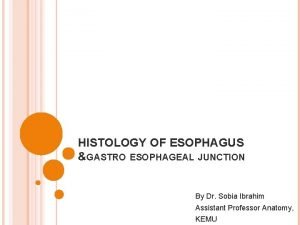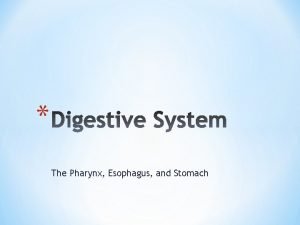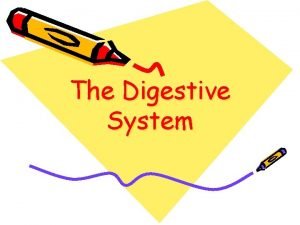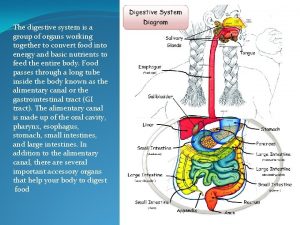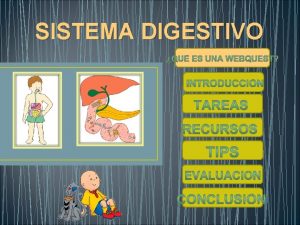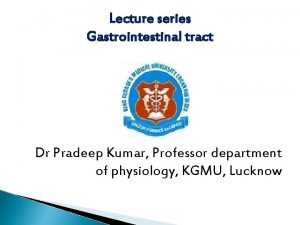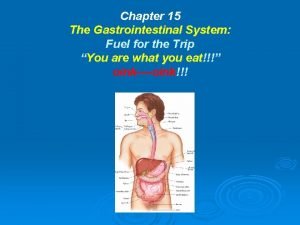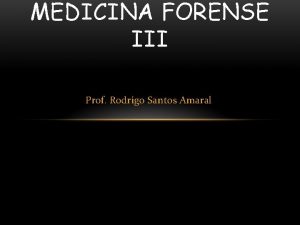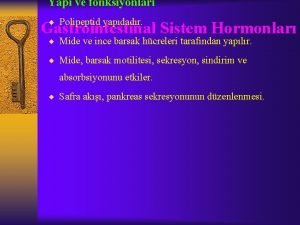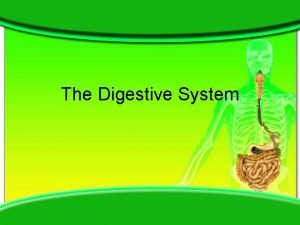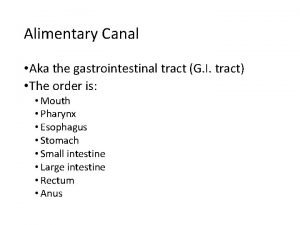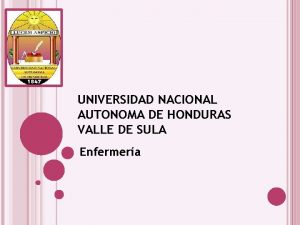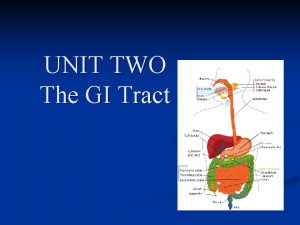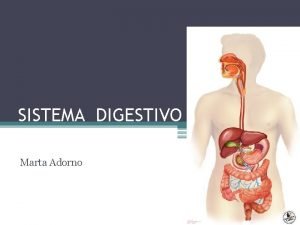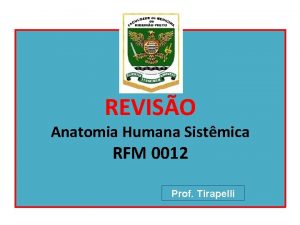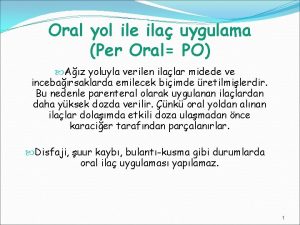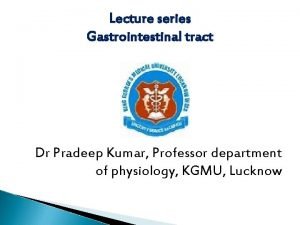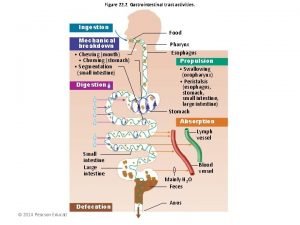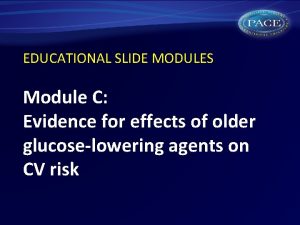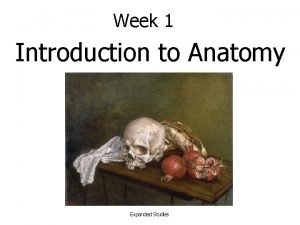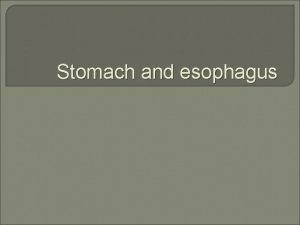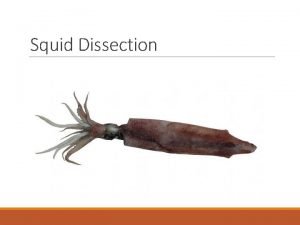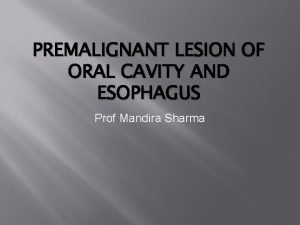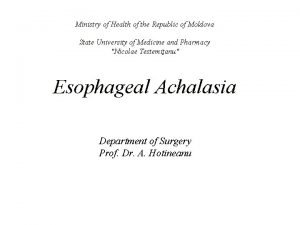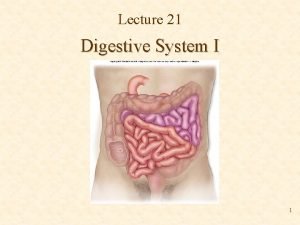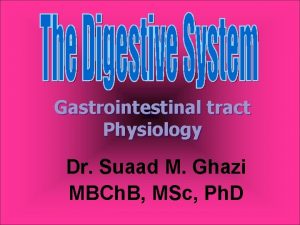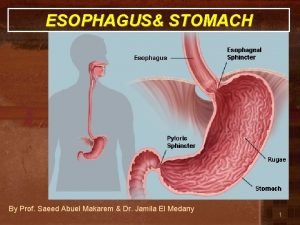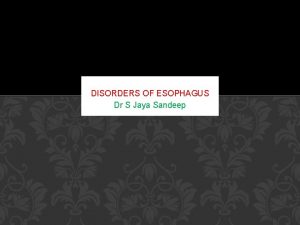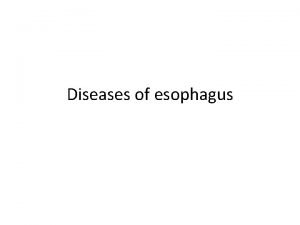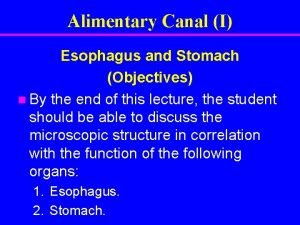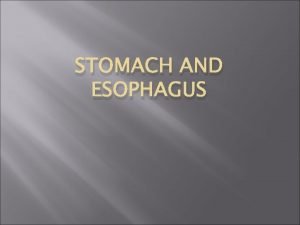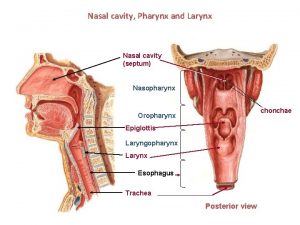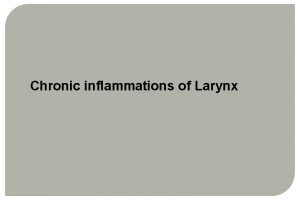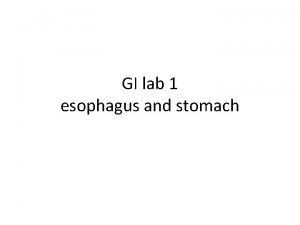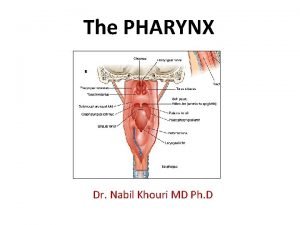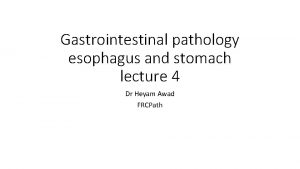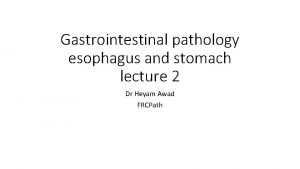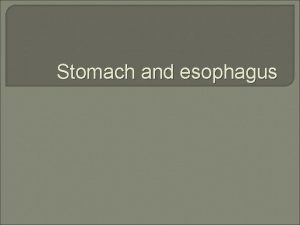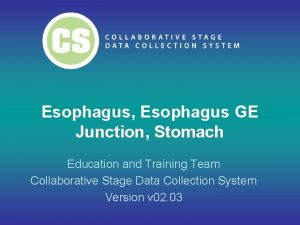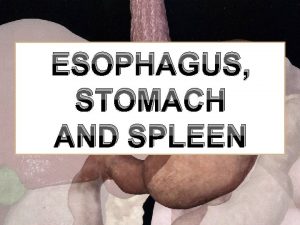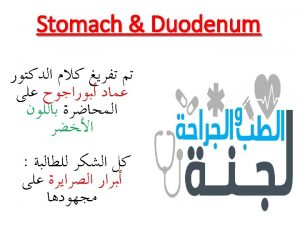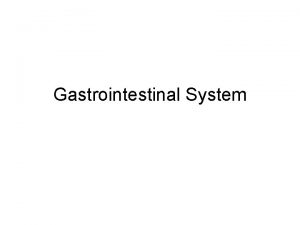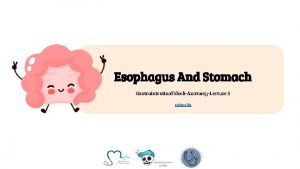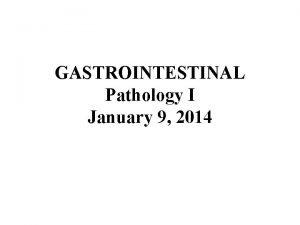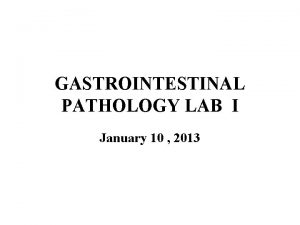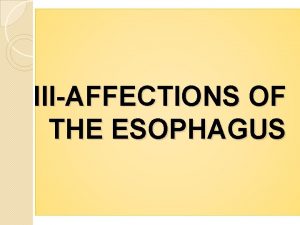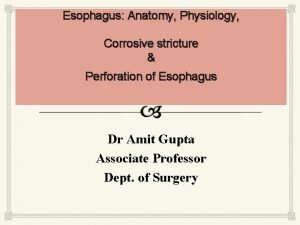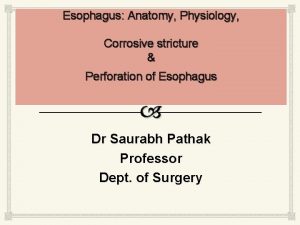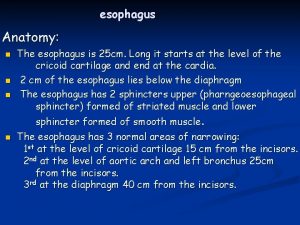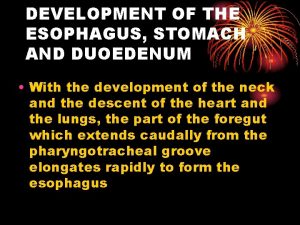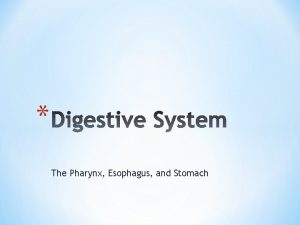Gastrointestinal pathology esophagus and stomach lecture 1 Dr















































- Slides: 47

Gastrointestinal pathology esophagus and stomach lecture 1 Dr Heyam Awad FRCPath

Pathology lectures in GI pathology subject Number of lectures lecturer Esophageal diseases 2 Dr H Awad Gastric disease 2 Dr H Awad Small intestine 2 Dr M Salihi Large intestine 2 Dr M Salihi liver 5 Dr M Shomaf pancreas 1 Dr M Shomaf Gall bladder 1 Dr M Shomaf


Types of diseases that can affect the esophagus • Obstruction inflammation

Esophageal diseases 1. 2. 3. 4. Obstruction Vascular diseases Inflammation Tumors

Esophageal obstruction • Can be mechanical or functional obstruction • Mechanical: the esophagus is obstructed due to developmental abnormality: atresia, fistula, or duplication. • Functional: caused by several conditions that affect normal motility.

Mechanical obstruction • Agenesis. • Atresia • Fistula • Duplication

ﺍﻟﻕ • Agenesis = no esophagus. extremely rare = AGENESIS

Atresia= ﺍﻧﺴﺪﺍﺩ= ﺍﻟﺮﺗﻖ • = Absence or closure of a natural passage or channel of the body. • Atresia of esophagus: thin non-canalized cord replaces a segment of esophagus • Atresia occurs mostly at or near tracheal bifurcation • Usually associated with fistula connecting upper or lower esophageal pouches to a bronchus or the trachea • This abnormal connection cause aspiration, suffocation, pneumonia or severe fluid and electrolyte imbalance



Atresia • Discovered shortly after birth because it causes regurgitation during feeding • Must be corrected surgically

Stenosis • Stenosis: thickening due to fibrous thickening of the submucosa, atrophy of muscularis propria, and secondary epithelial damage • Stenosis is usually due to inflammation and scarring which could be due to reflux, irradiation or caustic injury • These patients have dysphagia which is progressive. Difficulty in eating solids occurs long before problems with liquid

Caustic injury= corrosive injury • An injury of muco-cutaneous surfaces—e. g. , eyes, esophagus, skin— with tissue destruction due to direct contact with a strong acid or with a strong base.

Caustic injury

Functional obstruction • Efficient delivery of food to the stomach requires coordinated peristalsis of the muscles • Esophageal dysmotility interferes with these peristaltic contractions • Achalasia is the most important cause of functional obstruction.

achalasia

Achalasia= ﻻﺍﺭﺗﺨﺎﺋﻴﺔ • Caused by failure of the LES muscles to relax • = Incomplete LES relaxation, increases LES tone and aperestalsis • Can be Primary and secondary • Primary: failure of the distal esophageal inhibitory neurons. Idiopathic • Secondary= Chagas disease: Trypanosoma cruzi infection destroys myenteric plexus neurons

symptoms • Achalasia is characterized by difficulty in swallowing, regurgitation, and sometimes chest pain.

note • Achalasia like disease can occur in any disease that can affect the neuronal innervation of the esophageal muscles Examples: 1. diabetic autonomic neuropathy, 2. infiltrative disorders: malignancy, amyloidosis, sarcoidosis 3. lesions of dorsal motor nuclei like in polio or surgical ablation

Treatment

Diseases of blood vessels • The most important is : esophageal varices.

Normal blood flow to the GIT • Venous blood from GIT is delivered to the liver via the portal vein before reaching inferior vena cava. • So drugs and other materials absorbed in the intestines are processed by the liver before entering the systemic circulation • If this flow is impaired: portal hypertension develops. • Portal hypertension causes esophageal varices

Splanchnic circulation


Esophageal varices • One of the sites where the splanchnic and systemic circulation can communicate is the esophagus. • That’s why when portal hypertension increases, collateral vascular channels develop in the esophageal veins to allow blood to shunt from the portal to caval system (inferior vena cava) • These collateral veins (varices) enlarge and can rupture.

Causes of esophageal varices • Any disease that causes increased portal hypertension will result in esophageal varices • Liver cirrhosis is the most common cause worldwide, especially alcoholic liver disease • Hepatic schistosomiasis is the second most common cause.

morphology • Varices appear as tortuous dilated veins within the submucosa of distal esophagus and proximal stomach

Esophageal varices: note the dilated veseels

Clinical features • Varices are usually asymptomatic. • But, can rupture and cause hemorrhage • If hemorrhage is severe: can result in death • Half patients die from the first bleed • Those who survive: more than 50% will have another bleed that can be fatal • Variceal rupture is the most common cause of death associated with advanced cirrhosis.

Bleeding due to varices

Esophageal inflammations= esophagitis • Lacerations • Chemical esophagitis • Infectious esophagitis • Reflux esophagitis • Eosinophilic esophagitis • Barrett esophagus

Esophageal lacerations vomiting • Most common esophageal laceration: Mallory Weiss tears • Associated with severe vomiting or with acute alcohol intoxication • Normally there is a reflex relaxation of the gastroesophageal muscles before antiperistaltic contractile wave associated with vomiting • This reflex fails during prolonged vomiting resulting in esophageal wall stretch and tear. • Patients present with hematemesis ( bloody vomit) • The tears are longitudinal, superficial , cross the gastroesophageal junction and healing is usually rapid and complete… no surgical intervention is needed.


Mallory Weiss lacerationseiss

lacerations

Chemical esophagitis • Inflammation of the esophagus can result from chemicals like: alcohol, acids, bases, hot fluid, heavy smoking. • Pill induced esophagitis: medicinal pills lodge into the esophagus and dissolve there • Chemotherapy and radiotherapy can also cause esophagitis

infections • Herpes simplex: causes punched out ulcers • CMV: causes shallow ulcers • Candida: pseudo membrane

Ulcer. . This can be infectious

Herpes inclusions

candida

Reflux esophagitis • Is inflammation of the lower esophagus due to reflux of gastric contents, which are acidic, from the stomach to the esophagus. • It is the mot common cause of esophagitis Also called: gastroesphageal reflux disease GERD

pathogenesis • Reflux of gastric juices into esophagus causes mucosal injury in the esophagus Causes of this reflux • 1. Decreased LES tone will cause reflux: alcohol, smoking • 2. increased abdominal pressure: obesity, pregnancy, • 3. delayed gastric emptying and increased gastric volume • 4. in many cases, no cause is known !!

morphology • Hyperemia: redness… seen macroscopically or during endoscopy • Microscopically: eosinophils, neutrophils, basal zone hyperplasia, elongation of lamina propria papillae

Inflammation in esophagus GERD is the most common cause

Clinical features • Occurs in adults older than 40 • Symptoms: heartburn, dysphagia, regurgitation • Rarely: severe chest pain that can mimic heart disease • Complications: ulceration, strictures, Barrett's mucosa

 Histology of gastroesophageal junction
Histology of gastroesophageal junction Stomach parts name
Stomach parts name Digestive system for labelling
Digestive system for labelling Esophagus stomach small intestine large intestine
Esophagus stomach small intestine large intestine Emt chapter 18 gastrointestinal and urologic emergencies
Emt chapter 18 gastrointestinal and urologic emergencies 01:640:244 lecture notes - lecture 15: plat, idah, farad
01:640:244 lecture notes - lecture 15: plat, idah, farad Embriologia del sistema gastrointestinal
Embriologia del sistema gastrointestinal Gastrointestinal tract
Gastrointestinal tract Chemotrypsinogen
Chemotrypsinogen Chapter 15 the gastrointestinal system
Chapter 15 the gastrointestinal system Gastrointestinal hormones
Gastrointestinal hormones Sigid djuniawan
Sigid djuniawan Sinal de lichtenberg medicina legal
Sinal de lichtenberg medicina legal Pankreatik polipeptid
Pankreatik polipeptid Gastrointestinal medical terminology breakdown
Gastrointestinal medical terminology breakdown Nutrition focused physical assessment
Nutrition focused physical assessment Proctodeum
Proctodeum Composition of stomach
Composition of stomach Motilidad gastrointestinal
Motilidad gastrointestinal Dumping syndrome signs
Dumping syndrome signs Canal marta adorno
Canal marta adorno Sistema digestorio
Sistema digestorio Ashraf radwan
Ashraf radwan Oral yolu
Oral yolu Gastrointestinal structure
Gastrointestinal structure Peristalsis and segmentation
Peristalsis and segmentation Why does metformin cause diarrhea
Why does metformin cause diarrhea Distal organ
Distal organ Hirschsprung disease nursing management
Hirschsprung disease nursing management Pathophysiology of intestinal obstruction
Pathophysiology of intestinal obstruction Internal anatomy
Internal anatomy Lymphatic drainage of stomach
Lymphatic drainage of stomach External anatomy of a squid
External anatomy of a squid Premalignant lesions of esophagus
Premalignant lesions of esophagus Tortuous esophagus
Tortuous esophagus Pyloric orifice function
Pyloric orifice function Gastric glands
Gastric glands Region of abdomen
Region of abdomen Cervical portion of esophagus
Cervical portion of esophagus Peristaltic contraction
Peristaltic contraction Esophageal spasm
Esophageal spasm Nutcracker esophagus
Nutcracker esophagus Serosa vs adventitia
Serosa vs adventitia Stomach blood supply
Stomach blood supply Bronchiole
Bronchiole Mouse nibbled appearance
Mouse nibbled appearance Stomach
Stomach Pharynx skeletal muscle
Pharynx skeletal muscle
